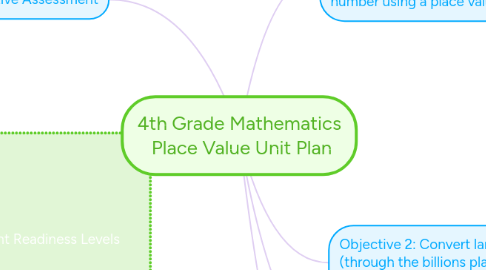
1. Student Readiness Levels
1.1. Above Grade Level: Group of 5 students who answered most, including the most difficult, of the pre-assessment questions correctly
1.2. At Grade Level: Group of 12 students who have some knowledge about the topic as shown in their score, but need to develop higher order thinking skills.
1.3. Bellow Grade Level: Group of 5 students who appear to have limited knowledge about the topic
2. Summative Assessment
2.1. Above Grade Level
2.1.1. Review Activity: Students write test questions and quiz each other.
2.1.2. Unit Test: Questions with the highest level of difficulty.
2.1.3. Extension Activity Large Numbers Project and Presentation
2.2. At Grade Level
2.2.1. Students complete review trivia.
2.2.2. Unit Test: Questions with some higher difficulty level questions
2.3. Bellow Grade Level
2.3.1. Students and teacher review concepts based on common mistakes of previous formative assessments.
2.3.2. Unit Test: Questions with the grade level of difficulty
3. Objective 1: In a large number (through the billions place), identify the place value of any one digit within the number using a place value chart.
3.1. Above Grade Level
3.1.1. A) Review place value by constructing a human place value line. Students lead others.
3.1.2. B) Complete practice problems with a partner.
3.1.3. Extension Activity: Large numbers project
3.1.4. Assessment: Check the problems against answer key. Corrections due in class.
3.2. At Grade Level
3.2.1. A) Introduce the concept of place value by constructing a human place value line.
3.2.2. B) Using white board, teach students to use a place value chart.
3.2.3. C) Complete practice problems with a partner.
3.2.4. Assessment: Completed and checked practice problems. Corrections for homework.
3.3. Bellow Grade Level
3.3.1. A) Introduce the concept of place value by constructing a human place value line.
3.3.2. B) Using white board, teach students to use a place value chart.
3.3.3. C) Students and teacher work together on practice problems.
3.3.4. Assessment: What stuck with you problem.
4. Objective 2: Convert large numbers (through the billions place) in standard form to word form and vice versa.
4.1. Above Grade Level
4.1.1. A) Demonstrate how to use place value chart to convert numbers from standard to word form and vv.
4.1.2. B) Help write game questions- Difficulty Level 2 and 3.
4.1.3. C) Flash cards on the game board. Difficulty Level 1.
4.2. At Grade Level
4.2.1. A) Demonstrate how to use place value chart to convert numbers from standard to word form and vv.
4.2.2. B) Practice problems.
4.2.3. C) Flash cards on the game board. Difficulty Level 2 questions.
4.2.4. Assessment: Quiz them with a Level 2 question.
4.3. Bellow Grade Level
4.3.1. A) Demonstrate how to use place value chart to convert numbers from standard to word form and vv.
4.3.2. B) Practice problems with the teacher, as a group.
4.3.3. C) Flash cards on the game board. Difficulty Level 3 questions.
4.3.4. Assessment: Quiz them with a Level 3 question.
5. Objective 3: Round whole numbers (expressed through the billions place) to the nearest tens, hundreds, thousands, ten thousands, etc.
5.1. Above Grade Level
5.1.1. A) Students lead demonstration outside constructing a life sized number line.
5.1.2. B) Complete practice problems with a partner.
5.1.3. Extension Activity: Continue working on project.
5.1.4. Assessment: Check problems against answer key. Corrections due in class.
5.2. At Grade Level
5.2.1. A) Demonstration outside constructing a life sized number line.
5.2.2. B) Practice problems as a group.
5.2.3. Assessment: Check problems against answer key. Corrections for H.W.
5.3. Bellow Grade Level
5.3.1. A) Demonstration outside constructing a life sized number line.
5.3.2. B) Teach students to set up a number line on paper. Use it to teach rounding using Color Coding Process.
5.3.3. C) Practice problems as a group, guided by the teacher.
5.3.4. Assessment: Exit Card Problem
6. Objective 4: Order large numbers by using a number line or place value chart and recording the results of comparisons with the symbols >, =, and <.
6.1. Above Grade Level
6.1.1. Review > and < signs using hungry crocodiles visual representations.
6.1.2. Play IXL Games- Place Value
6.1.3. Assessment: Completion of IXL problems
6.2. At Grade Level
6.2.1. Introduce > and < signs using hungry crocodiles visual representations.
6.2.2. Students draw their own crocodiles modeled after the teacher’s.
6.2.3. With a partner, they solve large number comparison problems.
6.2.4. Assessment: Switch problems with another pair of partners and check with each other.
6.3. Bellow Grade Level
6.3.1. Introduce > and < signs using hungry crocodiles visual representations.
6.3.2. Students draw their own crocodiles modeled after the teacher’s.
6.3.3. As a group, student and teacher complete practice sheet.

